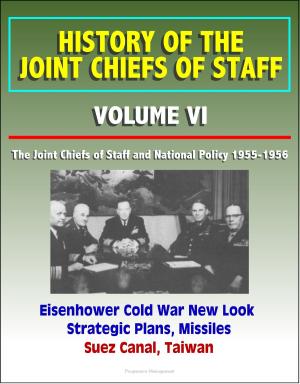A Giant in the Shadows: Major General Benjamin Foulois and the Rise of the Army Air Service in World War I - Beginnings of Military Aviation, War Department Buys Aeroplane, Foulois on Western Front
Nonfiction, History, Military, Aviation, World War I| Author: | Progressive Management | ISBN: | 9781310597350 |
| Publisher: | Progressive Management | Publication: | January 27, 2016 |
| Imprint: | Smashwords Edition | Language: | English |
| Author: | Progressive Management |
| ISBN: | 9781310597350 |
| Publisher: | Progressive Management |
| Publication: | January 27, 2016 |
| Imprint: | Smashwords Edition |
| Language: | English |
Professionally converted for accurate flowing-text e-book format reproduction, this paper examines the military career of Maj Gen Benjamin Foulois to determine how his personal qualities and professional skill enabled him to rapidly build up and lead the air arm of the American Expeditionary Forces (AEF) to victory in World War I. While previous academic works have focused on Foulois's early aviation career from 1909 to 1916 and his tenure as chief of the Air Corps from 1931 to 1935, nothing details the vital role he played in the development of the American Air Service leading up to and during World War I. Foulois's personal and moral courage allowed him to take on the weighty responsibility of designing and executing a $640 million plan to create a combat air force from scratch. After his poor performance as chief of the Air Service, this same courage enabled him to learn from his mistakes and return to the Air Service staff to complete the organizational buildup he started. His skill as a political infighter gave him the insight to advocate patiently for the air arm's interests within the halls of the Congress and the War Department instead of following Billy Mitchell's example of using the blunt instruments of criminal accusations in the court of public opinion to effect change. Foulois's leadership record during the war was mixed; he was much more effective as a logistician and troubleshooter for solving the Air Service's training, aircraft production, and contracting problems than as a combat leader on the front. While Foulois was one of the world's first writers on airpower theory, he chose to focus his later career on developing the technological and organizational innovations he felt were required to bring the airpower theories of others such as Mitchell, Douhet, and Trenchard to fruition. Foulois's leadership, tenacity, forward thinking, and organizational skill hold lessons for future Air Force leaders charged with a similar rapid establishment or expansion of new capabilities, such as a robust remotely piloted vehicle force or a cyber warfare arm of the Air Force.
Chapter 1 - Introduction * Chapter 2 - Foulois and the Beginnings of Military Aviation (1897-1913) * Early Life and First Enlistment in the Army * Second Enlistment and Two Tours in the Philippines * Professional Military Education and a Detour to Cuba * The Army Signal School Thesis * The War Department Buys an Aeroplane * Foulois Joins Army Aviation * " . . . and Teach Yourself to Fly" * Analysis * Chapter 3 - Organizing and Funding an Air Force (1914-17) * Fixing the Schoolhouse and Establishing the 1st Aero Squadron * First Combat—The Mexican Punitive Expedition of 1916 * America Enters the War and Purchases an Air Force * "Build a Large Something out of Nothing, and Build It Quickly" * Analysis * Chapter 4 - Leading the War in the Air (1917-18) * Reorganizing the Air Service * Meeting the Challenges * Change of Command * Analysis * Chapter 5 - To the Front and Back (1918-67) * Foulois on the Western Front * Back to the Air Service Staff * America's Record of Accomplishment * Foulois's Second Rise and Fall as Chief of the Air Arm * Analysis * Chapter 6 - Conclusion * The Man * The Political Infighter * The Leader * The Theorist * Implications * Bibliography
Professionally converted for accurate flowing-text e-book format reproduction, this paper examines the military career of Maj Gen Benjamin Foulois to determine how his personal qualities and professional skill enabled him to rapidly build up and lead the air arm of the American Expeditionary Forces (AEF) to victory in World War I. While previous academic works have focused on Foulois's early aviation career from 1909 to 1916 and his tenure as chief of the Air Corps from 1931 to 1935, nothing details the vital role he played in the development of the American Air Service leading up to and during World War I. Foulois's personal and moral courage allowed him to take on the weighty responsibility of designing and executing a $640 million plan to create a combat air force from scratch. After his poor performance as chief of the Air Service, this same courage enabled him to learn from his mistakes and return to the Air Service staff to complete the organizational buildup he started. His skill as a political infighter gave him the insight to advocate patiently for the air arm's interests within the halls of the Congress and the War Department instead of following Billy Mitchell's example of using the blunt instruments of criminal accusations in the court of public opinion to effect change. Foulois's leadership record during the war was mixed; he was much more effective as a logistician and troubleshooter for solving the Air Service's training, aircraft production, and contracting problems than as a combat leader on the front. While Foulois was one of the world's first writers on airpower theory, he chose to focus his later career on developing the technological and organizational innovations he felt were required to bring the airpower theories of others such as Mitchell, Douhet, and Trenchard to fruition. Foulois's leadership, tenacity, forward thinking, and organizational skill hold lessons for future Air Force leaders charged with a similar rapid establishment or expansion of new capabilities, such as a robust remotely piloted vehicle force or a cyber warfare arm of the Air Force.
Chapter 1 - Introduction * Chapter 2 - Foulois and the Beginnings of Military Aviation (1897-1913) * Early Life and First Enlistment in the Army * Second Enlistment and Two Tours in the Philippines * Professional Military Education and a Detour to Cuba * The Army Signal School Thesis * The War Department Buys an Aeroplane * Foulois Joins Army Aviation * " . . . and Teach Yourself to Fly" * Analysis * Chapter 3 - Organizing and Funding an Air Force (1914-17) * Fixing the Schoolhouse and Establishing the 1st Aero Squadron * First Combat—The Mexican Punitive Expedition of 1916 * America Enters the War and Purchases an Air Force * "Build a Large Something out of Nothing, and Build It Quickly" * Analysis * Chapter 4 - Leading the War in the Air (1917-18) * Reorganizing the Air Service * Meeting the Challenges * Change of Command * Analysis * Chapter 5 - To the Front and Back (1918-67) * Foulois on the Western Front * Back to the Air Service Staff * America's Record of Accomplishment * Foulois's Second Rise and Fall as Chief of the Air Arm * Analysis * Chapter 6 - Conclusion * The Man * The Political Infighter * The Leader * The Theorist * Implications * Bibliography















